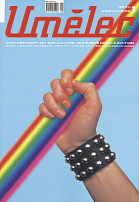| Umělec 2001/1 >> Stratil Twice Over | Просмотр всех номеров | ||||||||||||
|
|||||||||||||
Stratil Twice OverUmělec 2001/101.01.2001 Tomáš Pospiszyl | review | en cs |
|||||||||||||
|
"Václav Stratil, Drawings 1955-2000, Museum umění Olomouc, 30 November 2000 – 11 February 2001. Large “Black” Drawings, Gallery of Fine Arts, Dům Umění–Ostrava, 28 November 2000 – 27 January 2001
Once again Prague has been deemed too small for important exhibitions of Czech art and one has to set off to the regions to see them. But a little trip never hurt anyone, and this is especially true of a two-part exhibition of Václav Stratil in the cities of Olomouc and Ostrava. Although they “only” present his drawings, the loose definition of what might be considered a drawing made it possible for viewers to see an attempt at a partial retrospective of Stratil. Last year Václav Stratil celebrated his 50th birthday but Czech art history still doesn’t really know what to do with him. Although he made several works in the 1980s and 1990s that are today interpreted as milestones of Czech art, we are still perplexed about the others. His crosshatched drawings from the 1980s are something of a legend as he created works through a mechanical process of extraordinary metaphysical power: a gesture of Malevich’s square repeated millions of times; a record of meditation that is so empty it is ready to burst. Stratil also made a photographic series called Votary Patient, which deals more strongly and effectively than any other work in the Czech Republic to date with the theme of the artist’s changeable identity. In other works exhibited, Stratil bursts out as the naked king of contemporary art but the only response he gets is an awkward silence. Never mind. We don’t need to be hasty with categorization as for the past decade Stratil himself has been oscillating between many types of work without any obvious connection. But the two exhibitions in Olomouc and Ostrava showed that it is possible to find a surprising continuity even between works separated by several decades. The Olomouc part of Stratil’s drawing retrospective collected works from his childhood to the present day, including some little-known pieces from the 1970s. All together it’s quite a mess, as if you had ended up at an exhibition of several different persons living at different times. Some of them are not much different from the artistic expression common to a particular period, while others look as if they fell from Mars. In some we see pathetic seriousness, in others evolving jokes. In the best moments we have a feeling that Stratil has managed to immerse himself in art with such intensity that he has come out of it on the other side, all the while observing it and commenting on it with the relentless clarity of an outside spectator. Thinking about the briefly mentioned Votary Patient, one cannot help but ask why institutions concerned with printing books about art didn’t persuade Stratil to reproduce the series as a numbered edition. It might sell slowly but all the more steadily for that. The series Stray Dog was too small for the Rudolfinum Gallery six years ago. Its effect was diluted in those huge, unending halls down to a dimly perceptible, though recurring, trace intensity. Facing a small selection from the series in Olomouc, however, I marveled at how much a simple drawing of a frog’s head could say about the relationship between man and nature, the difference between an original and a copy, and ultimately about art itself and the way we are able to look at it. Also remarkable in this show are his abstract color collages from 1996, in which he used the flashy colors of advertising pages, stickers and price tags. In Ostrava, Stratil’s large black crosshatched drawings that he made from 1983 till the beginning of the 1990s were exhibited. Their formats, the manner of their installation and the radiation emanating from them leave no doubt that we are faced with a work of great significance. Viewers were literally walking through millions of lines, through cans of time, through traces of past human existence, through captured ages and the energy that all spent on art. Unfortunately, the absence of the other aspects of his work makes this part of the exhibition somewhat flat and suddenly we miss the variety and irregularity displayed in Olomouc. It is worth noting that a 90-page catalogue was printed to go along with the two exhibitions. Apart from images never before reproduced, the publication contains various older and hard-to-find catalogue essays and text written about Stratil’s work by Václav Zykmund, Jiří Valoch, Adriena Šimotová, Ladislav Daněk and others. It also includes a detailed list of his exhibitions and an extensive bibliography. Once Stratil has his real retrospective, the organizers will find a large portion of their work done and ready to use. Translated by Vladan Šír "
01.01.2001
Рекомендуемые статьи
|
|||||||||||||





Комментарии
Статья не была прокомментированаДобавить новый комментарий